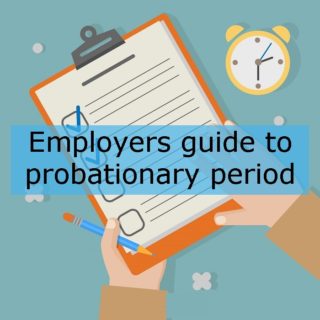Raveena Rani
Raveena is a seasoned International IP Counsel with a unique blend of engineering and legal acumen, specializing in Intellectual Property, Technology Law, and Corporate Transactions. She has extensive experience drafting and negotiating NDAs, commercial agreements, and legal documents in the areas of M&A, SaaS, and AI. Her global perspective is complemented by hands-on internships, corporate counsel roles, and mentoring initiatives. She thrives at the intersection of law, business, and technology.
Need any help? Contact us:

Table of Contents

What is a probationary period?
Nowadays, new appointments are usually subject to the completion of the probationary period. It’s worth pointing out that these increase the probability of new employees succeeding in their role. The main objective of this period is to give both the employer and employee some time to experience the role, expectations, and performance. The meaning of a probationary period is to put an employee under the supervision and record his performance. Depending upon the performance of the employee it can be extended or result in the termination of contract.
It basically gives the employer an opportunity to assess the performance of the employee and his suitability to the role while considering his skills, capabilities, conduct, and attendance. On the other hand, it also gives a chance to the employee to see if they like the job, work culture, and surroundings.
How long is the probationary period?
There is no law that determines the length of the probationary period. However, it has to be reasonable. Whilst it might be common for a more straightforward role to have a one month probationary period attached – in cases where performance and suitability can be assessed more readily – in most cases it is customary to see two-to-three months of probation period.
In more complex cases, where the employee-to-role fit is particularly important or the the employee is moving internally amongst different departments, it is possible to see probation periods as long as six months. In these cases, the eventual remuneration usually warrants the longer probationary periods.
Probation periods usually range from 1 to 6 months.
Before you begin with the probationary period
When an employee starts the probationary period, the employer should discuss the following things with the employee:
- Expectations from the employee during the probationary period.
- Core values of the organization and the behavior expected of the employee.
- The standards of regular attendance expected from the employee.
- The standards of customer service expected from the employee.
- Any development required to help the employee to do their job.
- How performance-related problems will be addressed.
- When the meeting for review of the probationary period will take place.
The process should be structured in a way so that both parties are clear about the expectations.
Training and support
The details of the structured training, guidance, and support of the new employee should be set by the manager. The employee should also be informed by the manager about the mechanism to help the employee identify and discuss any problem arising at the earliest opportunity.
Review during the probationary period
A number of formal review meetings should take place between the manager and the employee. For example:-
- Week 4
- Week 12
- Week 26
In order to help discussions during the meeting, the manager should make some notes prior to the meeting. Throughout the probationary process, a full clear record and documentation of the meetings should be kept by the manager. He has to ensure that the documentation should be signed by both the employee and the manager and the copy should be given to the employee.
When an employee on probation is experiencing difficulties
If at any stage, the employee experiences problems during his probationary period, the manager should be discussed with. The employee should not wait for the next review meeting. The main objective is to enhance the performance of the employee by giving him sufficient opportunities to achieve this. Where there are issues to be addressed, the following things need to be considered at any review meeting with the employee.
- Reinforce the areas where the employee is doing well.
- Discuss the shortcomings of the employee openly and honestly and provide documentary evidence whenever possible.
- Allow time and opportunity for an employee to respond.
- Try to resolve the problem by mutual consensus. If this is possible then the employee is more likely to react positively to any suggestions for improvement.
- Provide extra training, coaching, or supervision to overcome difficulties.
- Ensure that the process is well understood by the employee and the successful completion of the probationary period is dependent on it.
- Give warnings to an employee that if this standard is not reached, it will be necessary to terminate his/her employment.
- Where there is misconduct by the employee, warn the employee that any further misconduct will lead to immediate termination of contract.
Successful outcome of probationary period
Where the employee has successfully completed the probationary period, the employee should be informed by the manager at the final meeting that his appointment will be confirmed and an outcome will be sent to confirm this. The meaning of success of the probationary period is the completion of the probation period of the employee.
Extending the probationary period
The probationary period is mainly extended to allow sufficient time for an employee to improve his performance in order to demonstrate competence in the full range of duties and required behaviors. Where the employee’s performance is unsatisfactory in some areas during the probationary period and the manager feels that further training and support will help the employee to meet the required standards then an extension of the probationary period can be considered.
This could also be appropriate in cases where the employee or the manager has been absent from the workplace for an extended period during probation due to circumstances beyond the employee’s control. Where there are special circumstances justifying the course, an extension should normally be granted and can only be made before the end of the original probationary period.
How much longer a probation period can be reasonably extended will depend on the length of the first period. The probation period will subsequently be considered to be the accumulation of both periods. Where the manager agrees to extend the probationary period of the employee, the terms of the extension should be set out in writing. It is important to state clearly:-
- The length of the extension and the date on which the extended period will end.
- The reason for the extension – for example, the employee’s performance didn’t meet the required standards but the manager believes that the extension of time will help the employee to meet those standards.
- The performance standards or objectives that the employee is required to achieve by the end of the extended period of probation.
- Any guidance, training, or supervision required to be provided to the employee during the extension of the probationary period.
- By the end of the probationary period, if the required standards are not fully met by the employee, the employee’s employment will be terminated.
The extension of the probationary period should only be agreed upon where there are reasonable grounds to justify it. Therefore, it is not advisable to make extending probationary periods the norm.
Dismissal during probationary period
The manager will usually wait until the end of the probationary period to give a full opportunity to the employee before making any decision on termination of the contract. The meaning of probationary period dismissal is the termination of the contract of employment.
When a decision of termination of the contract of an employee at the end of the probationary period has been made, the manager will meet the employee after giving him five days’ notice in writing. The employee may be represented by a trade union representative or work colleague. Clear reasons will be set out by the manager as to why the employee has not successfully completed the probationary period and the employee will be given an opportunity to present his case including any mitigating circumstances.
Most policies or contracts of employment state that the full disciplinary procedure is not usually considered appropriate for employees working within the probationary period.
Where an employee has been dismissed without going through a fair process of dismissal, the employee can claim wrongful dismissal for which there is no length of service requirement. Wrongful dismissal occurs when an employer dismisses an employee in breach of the employer’s contractual or statutory obligations, for example by failing to follow a contractual disciplinary / dismissal procedure or failure to give contractual notice. In case of wrongful dismissal, the employer may be required to pay damages if the case is taken to an employment tribunal.





